Persuasive Essay: Why Exotic Animals Should Not Be Kept as Pets
VerifiedAdded on 2020/04/13
|7
|1829
|565
Essay
AI Summary
This persuasive essay argues against the practice of keeping exotic animals as pets, citing the harm they cause to both humans and the animals themselves. The essay highlights several key points: the dangers exotic pets pose to humans due to their unpredictable wild nature and potential for carrying zoonotic diseases; the cruel treatment of animals, often viewed as commodities or objects of sport, leading to neglect, abuse, and suffering; and the inadequate care provided by owners who lack the specialized knowledge and resources required for these animals' well-being. The essay emphasizes that exotic animals belong in their natural habitats and concludes that keeping them as pets is detrimental to both animal welfare and human safety. It provides various examples of animal cruelty and neglect to support its claims, calling for a shift in perspective to recognize these animals' sentience and intrinsic value, and advocating for their freedom in their natural environment.
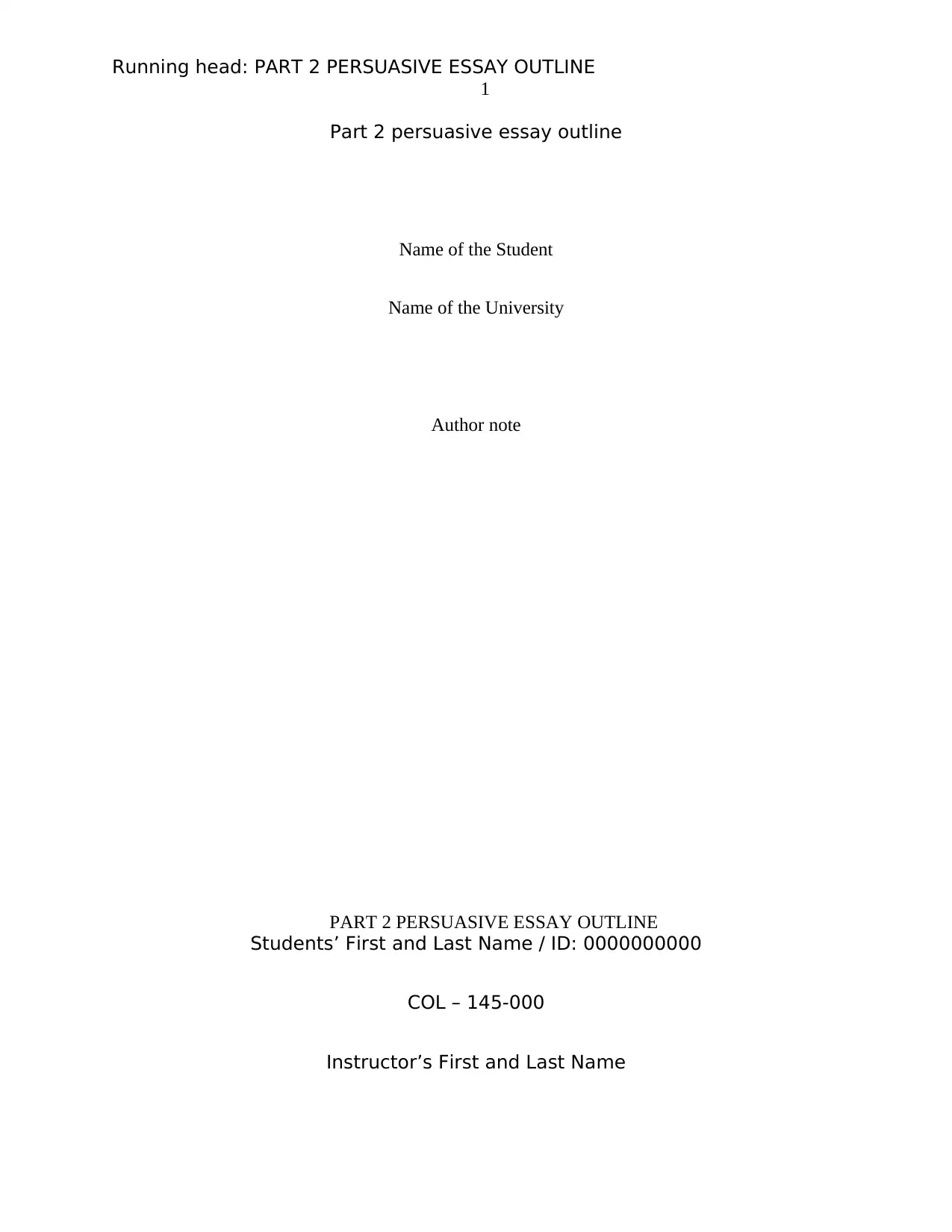
Running head: PART 2 PERSUASIVE ESSAY OUTLINE
1
Part 2 persuasive essay outline
Name of the Student
Name of the University
Author note
PART 2 PERSUASIVE ESSAY OUTLINE
Students’ First and Last Name / ID: 0000000000
COL – 145-000
Instructor’s First and Last Name
1
Part 2 persuasive essay outline
Name of the Student
Name of the University
Author note
PART 2 PERSUASIVE ESSAY OUTLINE
Students’ First and Last Name / ID: 0000000000
COL – 145-000
Instructor’s First and Last Name
Paraphrase This Document
Need a fresh take? Get an instant paraphrase of this document with our AI Paraphraser
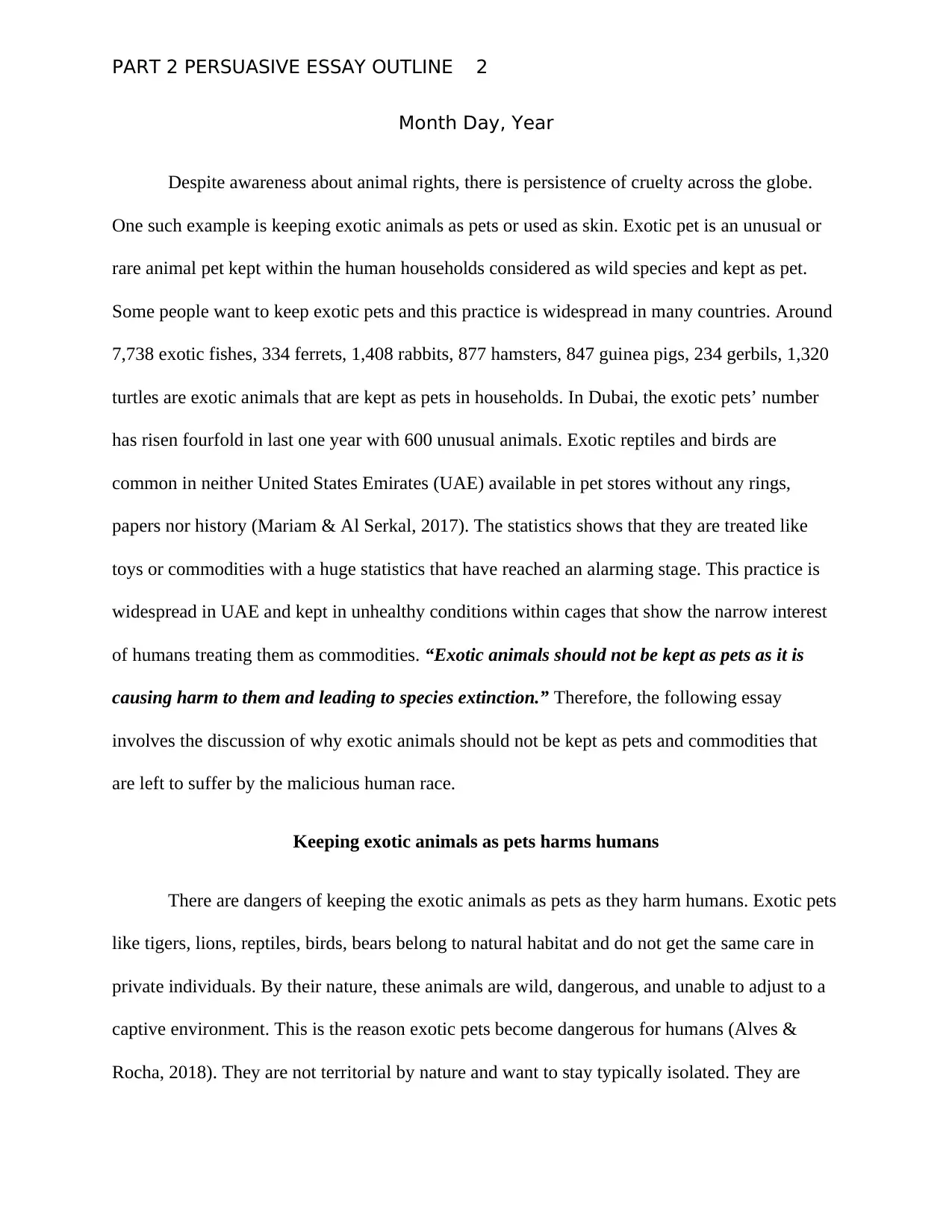
PART 2 PERSUASIVE ESSAY OUTLINE 2
Month Day, Year
Despite awareness about animal rights, there is persistence of cruelty across the globe.
One such example is keeping exotic animals as pets or used as skin. Exotic pet is an unusual or
rare animal pet kept within the human households considered as wild species and kept as pet.
Some people want to keep exotic pets and this practice is widespread in many countries. Around
7,738 exotic fishes, 334 ferrets, 1,408 rabbits, 877 hamsters, 847 guinea pigs, 234 gerbils, 1,320
turtles are exotic animals that are kept as pets in households. In Dubai, the exotic pets’ number
has risen fourfold in last one year with 600 unusual animals. Exotic reptiles and birds are
common in neither United States Emirates (UAE) available in pet stores without any rings,
papers nor history (Mariam & Al Serkal, 2017). The statistics shows that they are treated like
toys or commodities with a huge statistics that have reached an alarming stage. This practice is
widespread in UAE and kept in unhealthy conditions within cages that show the narrow interest
of humans treating them as commodities. “Exotic animals should not be kept as pets as it is
causing harm to them and leading to species extinction.” Therefore, the following essay
involves the discussion of why exotic animals should not be kept as pets and commodities that
are left to suffer by the malicious human race.
Keeping exotic animals as pets harms humans
There are dangers of keeping the exotic animals as pets as they harm humans. Exotic pets
like tigers, lions, reptiles, birds, bears belong to natural habitat and do not get the same care in
private individuals. By their nature, these animals are wild, dangerous, and unable to adjust to a
captive environment. This is the reason exotic pets become dangerous for humans (Alves &
Rocha, 2018). They are not territorial by nature and want to stay typically isolated. They are
Month Day, Year
Despite awareness about animal rights, there is persistence of cruelty across the globe.
One such example is keeping exotic animals as pets or used as skin. Exotic pet is an unusual or
rare animal pet kept within the human households considered as wild species and kept as pet.
Some people want to keep exotic pets and this practice is widespread in many countries. Around
7,738 exotic fishes, 334 ferrets, 1,408 rabbits, 877 hamsters, 847 guinea pigs, 234 gerbils, 1,320
turtles are exotic animals that are kept as pets in households. In Dubai, the exotic pets’ number
has risen fourfold in last one year with 600 unusual animals. Exotic reptiles and birds are
common in neither United States Emirates (UAE) available in pet stores without any rings,
papers nor history (Mariam & Al Serkal, 2017). The statistics shows that they are treated like
toys or commodities with a huge statistics that have reached an alarming stage. This practice is
widespread in UAE and kept in unhealthy conditions within cages that show the narrow interest
of humans treating them as commodities. “Exotic animals should not be kept as pets as it is
causing harm to them and leading to species extinction.” Therefore, the following essay
involves the discussion of why exotic animals should not be kept as pets and commodities that
are left to suffer by the malicious human race.
Keeping exotic animals as pets harms humans
There are dangers of keeping the exotic animals as pets as they harm humans. Exotic pets
like tigers, lions, reptiles, birds, bears belong to natural habitat and do not get the same care in
private individuals. By their nature, these animals are wild, dangerous, and unable to adjust to a
captive environment. This is the reason exotic pets become dangerous for humans (Alves &
Rocha, 2018). They are not territorial by nature and want to stay typically isolated. They are
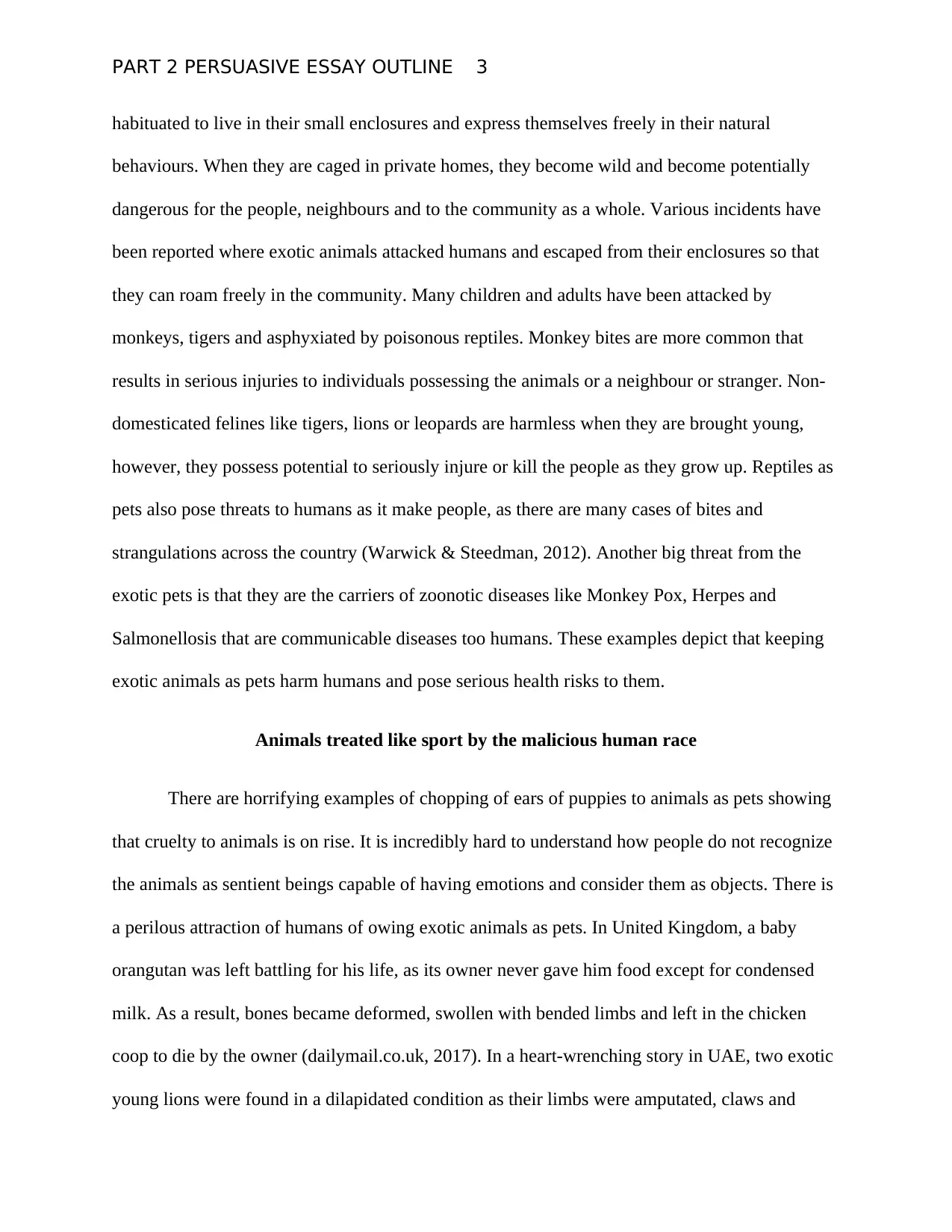
PART 2 PERSUASIVE ESSAY OUTLINE 3
habituated to live in their small enclosures and express themselves freely in their natural
behaviours. When they are caged in private homes, they become wild and become potentially
dangerous for the people, neighbours and to the community as a whole. Various incidents have
been reported where exotic animals attacked humans and escaped from their enclosures so that
they can roam freely in the community. Many children and adults have been attacked by
monkeys, tigers and asphyxiated by poisonous reptiles. Monkey bites are more common that
results in serious injuries to individuals possessing the animals or a neighbour or stranger. Non-
domesticated felines like tigers, lions or leopards are harmless when they are brought young,
however, they possess potential to seriously injure or kill the people as they grow up. Reptiles as
pets also pose threats to humans as it make people, as there are many cases of bites and
strangulations across the country (Warwick & Steedman, 2012). Another big threat from the
exotic pets is that they are the carriers of zoonotic diseases like Monkey Pox, Herpes and
Salmonellosis that are communicable diseases too humans. These examples depict that keeping
exotic animals as pets harm humans and pose serious health risks to them.
Animals treated like sport by the malicious human race
There are horrifying examples of chopping of ears of puppies to animals as pets showing
that cruelty to animals is on rise. It is incredibly hard to understand how people do not recognize
the animals as sentient beings capable of having emotions and consider them as objects. There is
a perilous attraction of humans of owing exotic animals as pets. In United Kingdom, a baby
orangutan was left battling for his life, as its owner never gave him food except for condensed
milk. As a result, bones became deformed, swollen with bended limbs and left in the chicken
coop to die by the owner (dailymail.co.uk, 2017). In a heart-wrenching story in UAE, two exotic
young lions were found in a dilapidated condition as their limbs were amputated, claws and
habituated to live in their small enclosures and express themselves freely in their natural
behaviours. When they are caged in private homes, they become wild and become potentially
dangerous for the people, neighbours and to the community as a whole. Various incidents have
been reported where exotic animals attacked humans and escaped from their enclosures so that
they can roam freely in the community. Many children and adults have been attacked by
monkeys, tigers and asphyxiated by poisonous reptiles. Monkey bites are more common that
results in serious injuries to individuals possessing the animals or a neighbour or stranger. Non-
domesticated felines like tigers, lions or leopards are harmless when they are brought young,
however, they possess potential to seriously injure or kill the people as they grow up. Reptiles as
pets also pose threats to humans as it make people, as there are many cases of bites and
strangulations across the country (Warwick & Steedman, 2012). Another big threat from the
exotic pets is that they are the carriers of zoonotic diseases like Monkey Pox, Herpes and
Salmonellosis that are communicable diseases too humans. These examples depict that keeping
exotic animals as pets harm humans and pose serious health risks to them.
Animals treated like sport by the malicious human race
There are horrifying examples of chopping of ears of puppies to animals as pets showing
that cruelty to animals is on rise. It is incredibly hard to understand how people do not recognize
the animals as sentient beings capable of having emotions and consider them as objects. There is
a perilous attraction of humans of owing exotic animals as pets. In United Kingdom, a baby
orangutan was left battling for his life, as its owner never gave him food except for condensed
milk. As a result, bones became deformed, swollen with bended limbs and left in the chicken
coop to die by the owner (dailymail.co.uk, 2017). In a heart-wrenching story in UAE, two exotic
young lions were found in a dilapidated condition as their limbs were amputated, claws and
⊘ This is a preview!⊘
Do you want full access?
Subscribe today to unlock all pages.

Trusted by 1+ million students worldwide
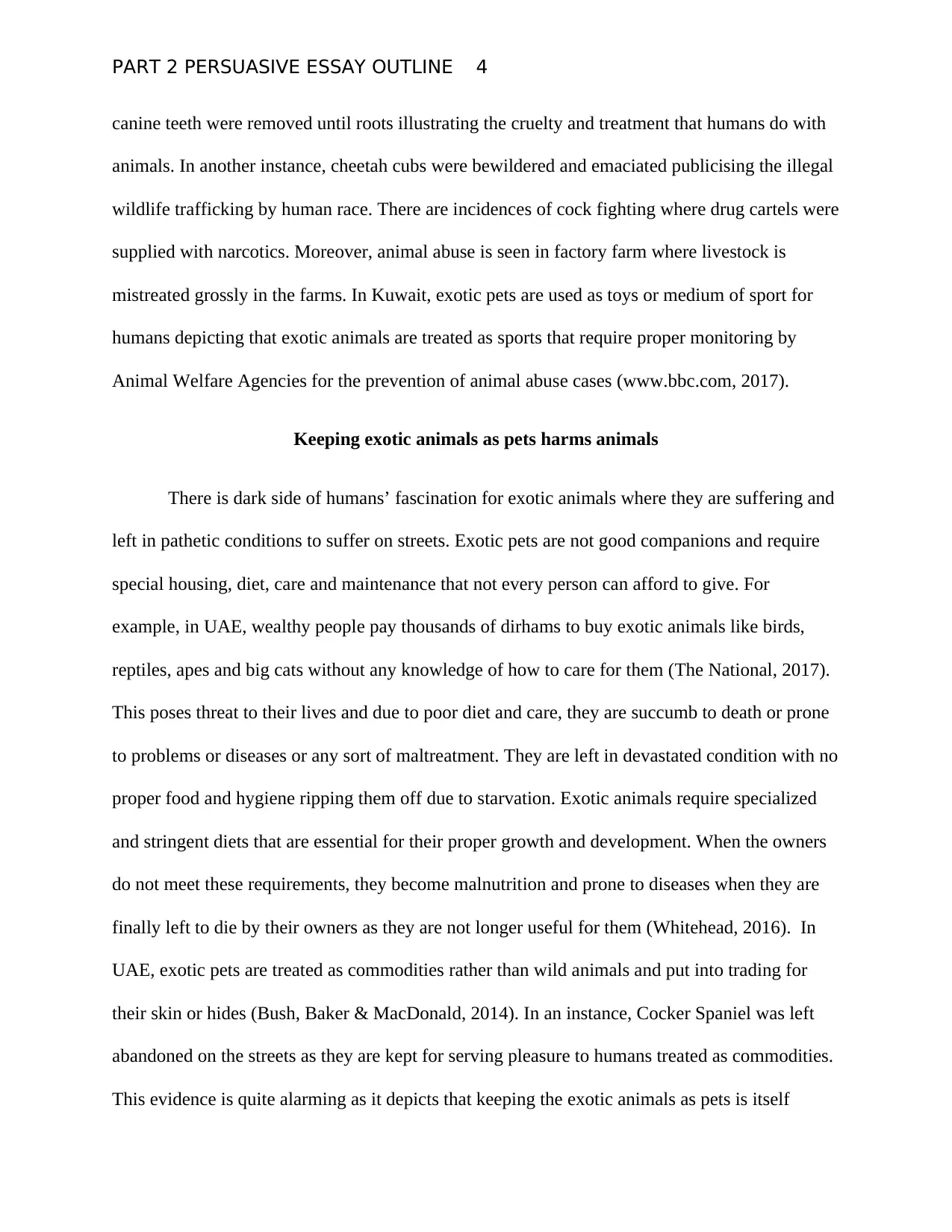
PART 2 PERSUASIVE ESSAY OUTLINE 4
canine teeth were removed until roots illustrating the cruelty and treatment that humans do with
animals. In another instance, cheetah cubs were bewildered and emaciated publicising the illegal
wildlife trafficking by human race. There are incidences of cock fighting where drug cartels were
supplied with narcotics. Moreover, animal abuse is seen in factory farm where livestock is
mistreated grossly in the farms. In Kuwait, exotic pets are used as toys or medium of sport for
humans depicting that exotic animals are treated as sports that require proper monitoring by
Animal Welfare Agencies for the prevention of animal abuse cases (www.bbc.com, 2017).
Keeping exotic animals as pets harms animals
There is dark side of humans’ fascination for exotic animals where they are suffering and
left in pathetic conditions to suffer on streets. Exotic pets are not good companions and require
special housing, diet, care and maintenance that not every person can afford to give. For
example, in UAE, wealthy people pay thousands of dirhams to buy exotic animals like birds,
reptiles, apes and big cats without any knowledge of how to care for them (The National, 2017).
This poses threat to their lives and due to poor diet and care, they are succumb to death or prone
to problems or diseases or any sort of maltreatment. They are left in devastated condition with no
proper food and hygiene ripping them off due to starvation. Exotic animals require specialized
and stringent diets that are essential for their proper growth and development. When the owners
do not meet these requirements, they become malnutrition and prone to diseases when they are
finally left to die by their owners as they are not longer useful for them (Whitehead, 2016). In
UAE, exotic pets are treated as commodities rather than wild animals and put into trading for
their skin or hides (Bush, Baker & MacDonald, 2014). In an instance, Cocker Spaniel was left
abandoned on the streets as they are kept for serving pleasure to humans treated as commodities.
This evidence is quite alarming as it depicts that keeping the exotic animals as pets is itself
canine teeth were removed until roots illustrating the cruelty and treatment that humans do with
animals. In another instance, cheetah cubs were bewildered and emaciated publicising the illegal
wildlife trafficking by human race. There are incidences of cock fighting where drug cartels were
supplied with narcotics. Moreover, animal abuse is seen in factory farm where livestock is
mistreated grossly in the farms. In Kuwait, exotic pets are used as toys or medium of sport for
humans depicting that exotic animals are treated as sports that require proper monitoring by
Animal Welfare Agencies for the prevention of animal abuse cases (www.bbc.com, 2017).
Keeping exotic animals as pets harms animals
There is dark side of humans’ fascination for exotic animals where they are suffering and
left in pathetic conditions to suffer on streets. Exotic pets are not good companions and require
special housing, diet, care and maintenance that not every person can afford to give. For
example, in UAE, wealthy people pay thousands of dirhams to buy exotic animals like birds,
reptiles, apes and big cats without any knowledge of how to care for them (The National, 2017).
This poses threat to their lives and due to poor diet and care, they are succumb to death or prone
to problems or diseases or any sort of maltreatment. They are left in devastated condition with no
proper food and hygiene ripping them off due to starvation. Exotic animals require specialized
and stringent diets that are essential for their proper growth and development. When the owners
do not meet these requirements, they become malnutrition and prone to diseases when they are
finally left to die by their owners as they are not longer useful for them (Whitehead, 2016). In
UAE, exotic pets are treated as commodities rather than wild animals and put into trading for
their skin or hides (Bush, Baker & MacDonald, 2014). In an instance, Cocker Spaniel was left
abandoned on the streets as they are kept for serving pleasure to humans treated as commodities.
This evidence is quite alarming as it depicts that keeping the exotic animals as pets is itself
Paraphrase This Document
Need a fresh take? Get an instant paraphrase of this document with our AI Paraphraser
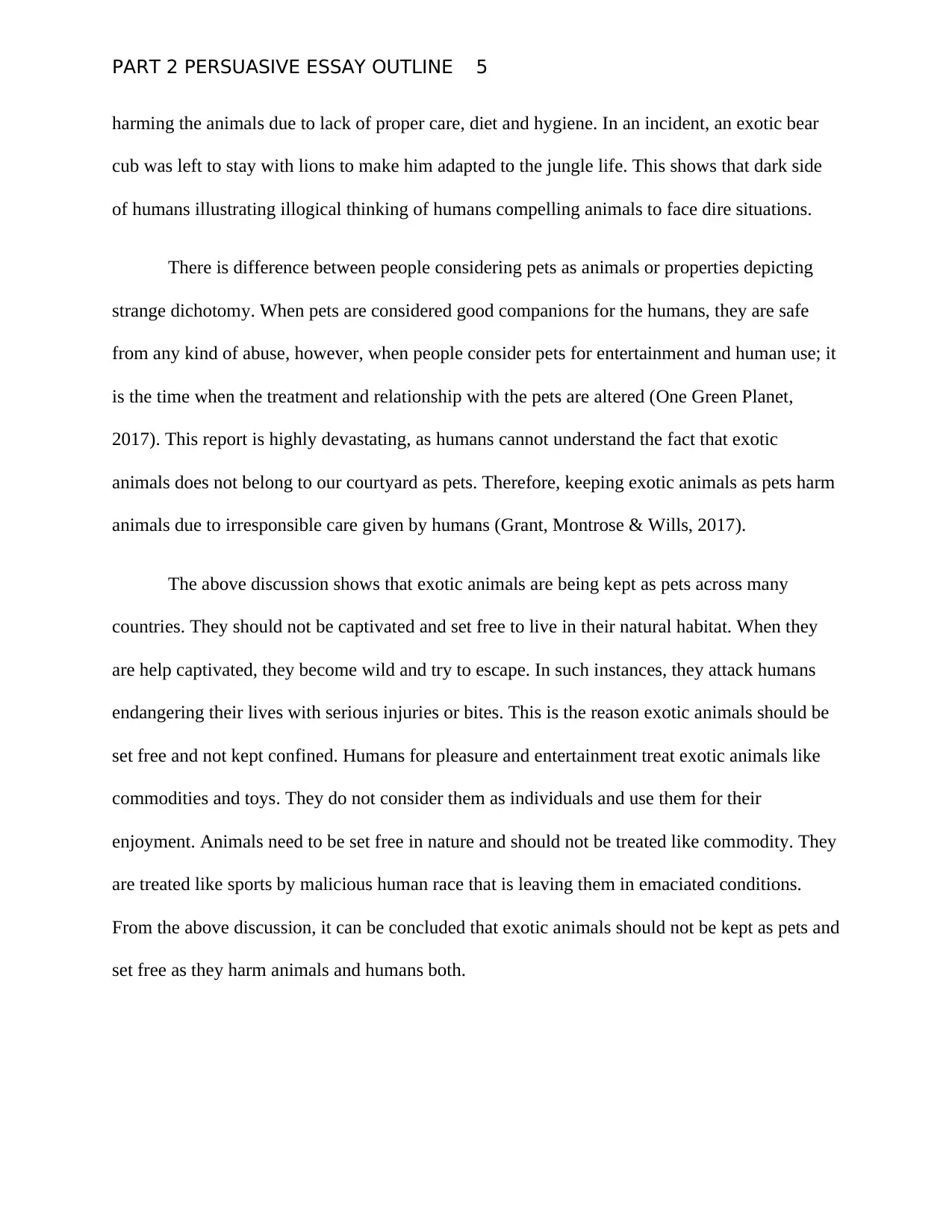
PART 2 PERSUASIVE ESSAY OUTLINE 5
harming the animals due to lack of proper care, diet and hygiene. In an incident, an exotic bear
cub was left to stay with lions to make him adapted to the jungle life. This shows that dark side
of humans illustrating illogical thinking of humans compelling animals to face dire situations.
There is difference between people considering pets as animals or properties depicting
strange dichotomy. When pets are considered good companions for the humans, they are safe
from any kind of abuse, however, when people consider pets for entertainment and human use; it
is the time when the treatment and relationship with the pets are altered (One Green Planet,
2017). This report is highly devastating, as humans cannot understand the fact that exotic
animals does not belong to our courtyard as pets. Therefore, keeping exotic animals as pets harm
animals due to irresponsible care given by humans (Grant, Montrose & Wills, 2017).
The above discussion shows that exotic animals are being kept as pets across many
countries. They should not be captivated and set free to live in their natural habitat. When they
are help captivated, they become wild and try to escape. In such instances, they attack humans
endangering their lives with serious injuries or bites. This is the reason exotic animals should be
set free and not kept confined. Humans for pleasure and entertainment treat exotic animals like
commodities and toys. They do not consider them as individuals and use them for their
enjoyment. Animals need to be set free in nature and should not be treated like commodity. They
are treated like sports by malicious human race that is leaving them in emaciated conditions.
From the above discussion, it can be concluded that exotic animals should not be kept as pets and
set free as they harm animals and humans both.
harming the animals due to lack of proper care, diet and hygiene. In an incident, an exotic bear
cub was left to stay with lions to make him adapted to the jungle life. This shows that dark side
of humans illustrating illogical thinking of humans compelling animals to face dire situations.
There is difference between people considering pets as animals or properties depicting
strange dichotomy. When pets are considered good companions for the humans, they are safe
from any kind of abuse, however, when people consider pets for entertainment and human use; it
is the time when the treatment and relationship with the pets are altered (One Green Planet,
2017). This report is highly devastating, as humans cannot understand the fact that exotic
animals does not belong to our courtyard as pets. Therefore, keeping exotic animals as pets harm
animals due to irresponsible care given by humans (Grant, Montrose & Wills, 2017).
The above discussion shows that exotic animals are being kept as pets across many
countries. They should not be captivated and set free to live in their natural habitat. When they
are help captivated, they become wild and try to escape. In such instances, they attack humans
endangering their lives with serious injuries or bites. This is the reason exotic animals should be
set free and not kept confined. Humans for pleasure and entertainment treat exotic animals like
commodities and toys. They do not consider them as individuals and use them for their
enjoyment. Animals need to be set free in nature and should not be treated like commodity. They
are treated like sports by malicious human race that is leaving them in emaciated conditions.
From the above discussion, it can be concluded that exotic animals should not be kept as pets and
set free as they harm animals and humans both.
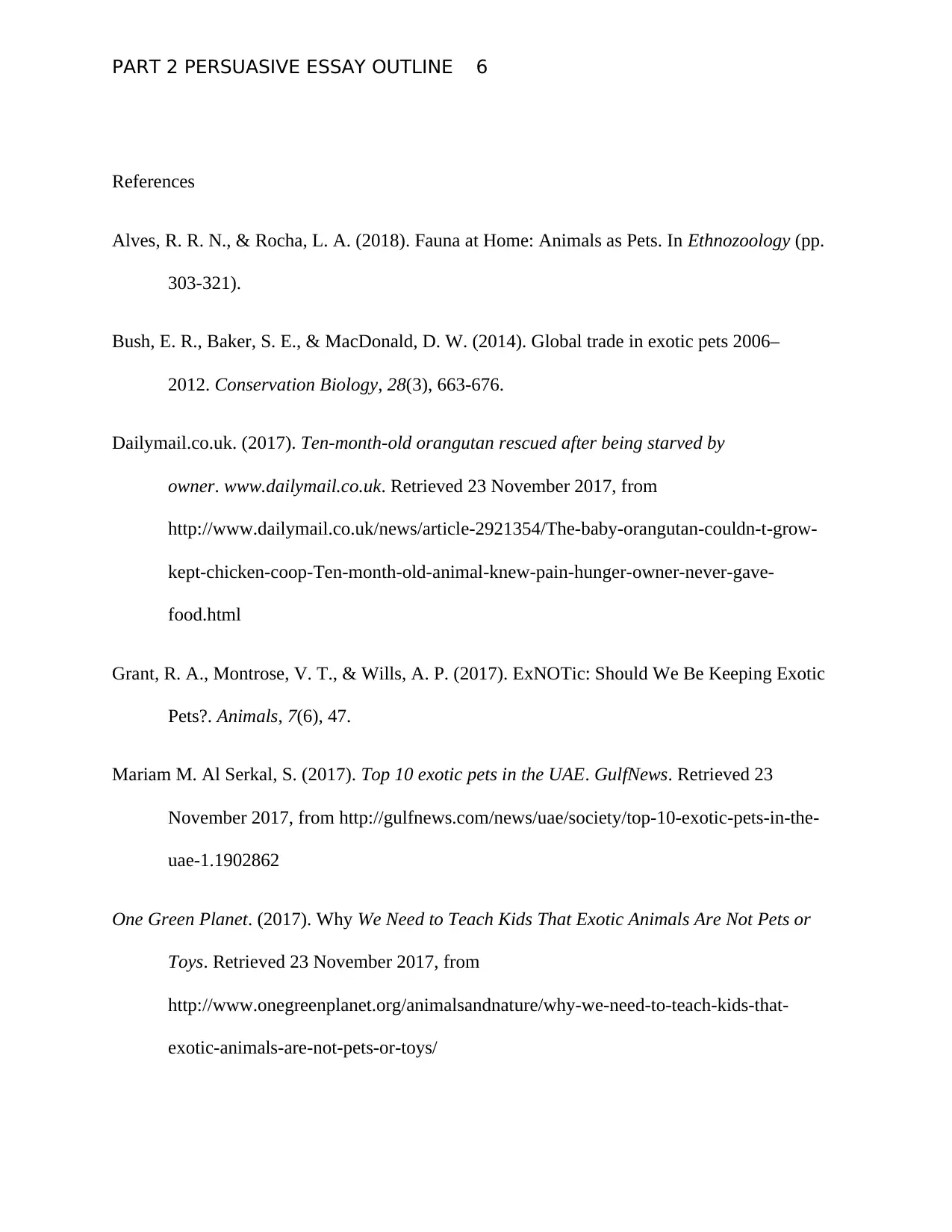
PART 2 PERSUASIVE ESSAY OUTLINE 6
References
Alves, R. R. N., & Rocha, L. A. (2018). Fauna at Home: Animals as Pets. In Ethnozoology (pp.
303-321).
Bush, E. R., Baker, S. E., & MacDonald, D. W. (2014). Global trade in exotic pets 2006–
2012. Conservation Biology, 28(3), 663-676.
Dailymail.co.uk. (2017). Ten-month-old orangutan rescued after being starved by
owner. www.dailymail.co.uk. Retrieved 23 November 2017, from
http://www.dailymail.co.uk/news/article-2921354/The-baby-orangutan-couldn-t-grow-
kept-chicken-coop-Ten-month-old-animal-knew-pain-hunger-owner-never-gave-
food.html
Grant, R. A., Montrose, V. T., & Wills, A. P. (2017). ExNOTic: Should We Be Keeping Exotic
Pets?. Animals, 7(6), 47.
Mariam M. Al Serkal, S. (2017). Top 10 exotic pets in the UAE. GulfNews. Retrieved 23
November 2017, from http://gulfnews.com/news/uae/society/top-10-exotic-pets-in-the-
uae-1.1902862
One Green Planet. (2017). Why We Need to Teach Kids That Exotic Animals Are Not Pets or
Toys. Retrieved 23 November 2017, from
http://www.onegreenplanet.org/animalsandnature/why-we-need-to-teach-kids-that-
exotic-animals-are-not-pets-or-toys/
References
Alves, R. R. N., & Rocha, L. A. (2018). Fauna at Home: Animals as Pets. In Ethnozoology (pp.
303-321).
Bush, E. R., Baker, S. E., & MacDonald, D. W. (2014). Global trade in exotic pets 2006–
2012. Conservation Biology, 28(3), 663-676.
Dailymail.co.uk. (2017). Ten-month-old orangutan rescued after being starved by
owner. www.dailymail.co.uk. Retrieved 23 November 2017, from
http://www.dailymail.co.uk/news/article-2921354/The-baby-orangutan-couldn-t-grow-
kept-chicken-coop-Ten-month-old-animal-knew-pain-hunger-owner-never-gave-
food.html
Grant, R. A., Montrose, V. T., & Wills, A. P. (2017). ExNOTic: Should We Be Keeping Exotic
Pets?. Animals, 7(6), 47.
Mariam M. Al Serkal, S. (2017). Top 10 exotic pets in the UAE. GulfNews. Retrieved 23
November 2017, from http://gulfnews.com/news/uae/society/top-10-exotic-pets-in-the-
uae-1.1902862
One Green Planet. (2017). Why We Need to Teach Kids That Exotic Animals Are Not Pets or
Toys. Retrieved 23 November 2017, from
http://www.onegreenplanet.org/animalsandnature/why-we-need-to-teach-kids-that-
exotic-animals-are-not-pets-or-toys/
⊘ This is a preview!⊘
Do you want full access?
Subscribe today to unlock all pages.

Trusted by 1+ million students worldwide
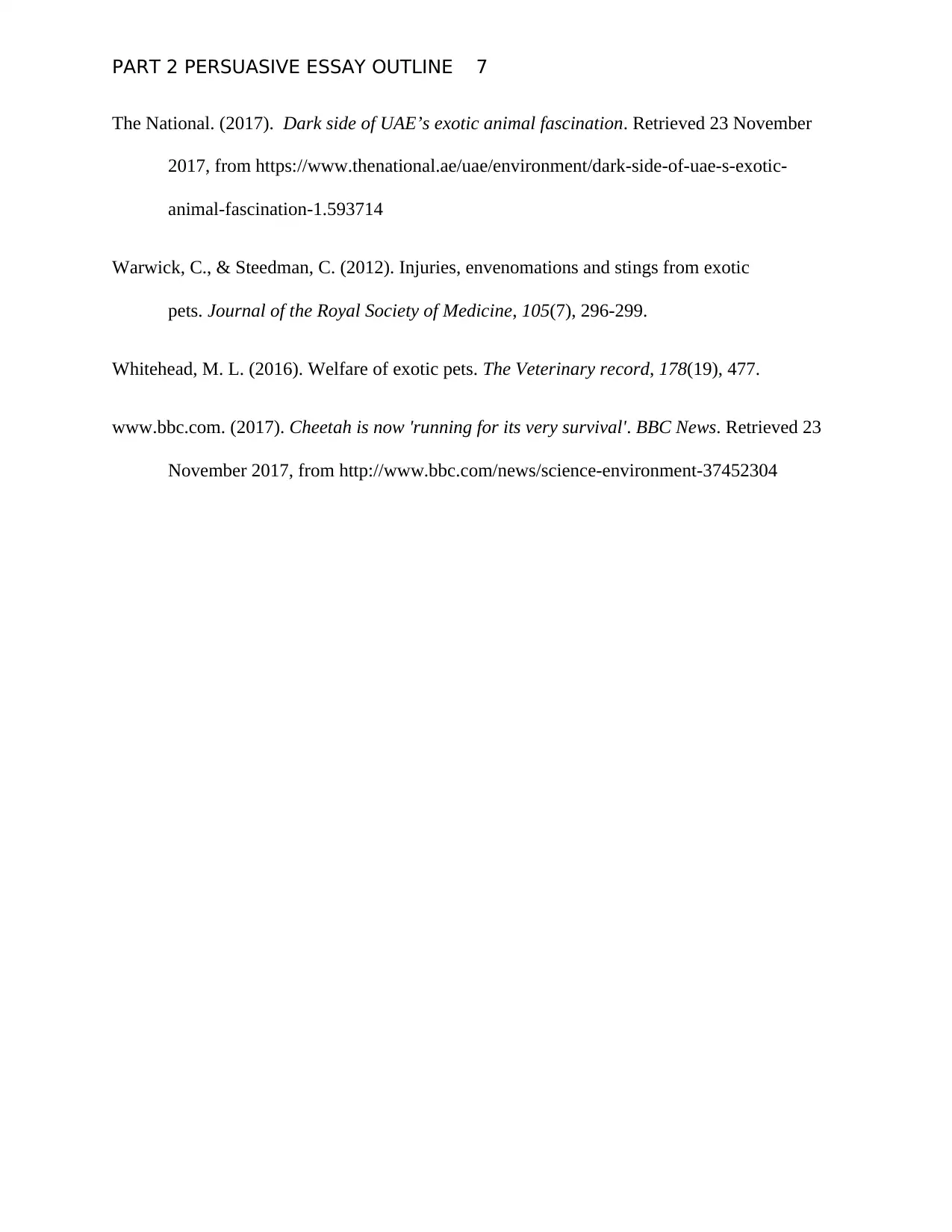
PART 2 PERSUASIVE ESSAY OUTLINE 7
The National. (2017). Dark side of UAE’s exotic animal fascination. Retrieved 23 November
2017, from https://www.thenational.ae/uae/environment/dark-side-of-uae-s-exotic-
animal-fascination-1.593714
Warwick, C., & Steedman, C. (2012). Injuries, envenomations and stings from exotic
pets. Journal of the Royal Society of Medicine, 105(7), 296-299.
Whitehead, M. L. (2016). Welfare of exotic pets. The Veterinary record, 178(19), 477.
www.bbc.com. (2017). Cheetah is now 'running for its very survival'. BBC News. Retrieved 23
November 2017, from http://www.bbc.com/news/science-environment-37452304
The National. (2017). Dark side of UAE’s exotic animal fascination. Retrieved 23 November
2017, from https://www.thenational.ae/uae/environment/dark-side-of-uae-s-exotic-
animal-fascination-1.593714
Warwick, C., & Steedman, C. (2012). Injuries, envenomations and stings from exotic
pets. Journal of the Royal Society of Medicine, 105(7), 296-299.
Whitehead, M. L. (2016). Welfare of exotic pets. The Veterinary record, 178(19), 477.
www.bbc.com. (2017). Cheetah is now 'running for its very survival'. BBC News. Retrieved 23
November 2017, from http://www.bbc.com/news/science-environment-37452304
1 out of 7
Your All-in-One AI-Powered Toolkit for Academic Success.
+13062052269
info@desklib.com
Available 24*7 on WhatsApp / Email
![[object Object]](/_next/static/media/star-bottom.7253800d.svg)
Unlock your academic potential
Copyright © 2020–2025 A2Z Services. All Rights Reserved. Developed and managed by ZUCOL.